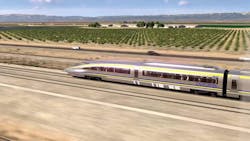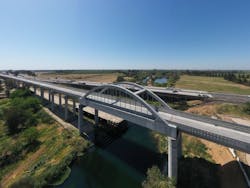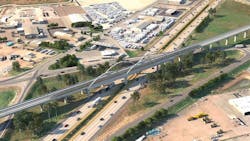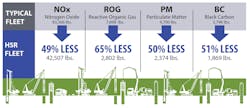Paving the way for high-speed rail in the U.S.
With over 39.3 million residents, California is the fifth-largest economy in the world and third largest U.S. state by area. Yet California’s transportation infrastructure has not expanded at a rate that matches the increase in population, tourism, and economic growth in the state, with most current highways, airports, and rail networks already operating at or over capacity.
A need exists to implement additional infrastructure to match transportation needs and connect distant mega-regions across diverse terrains and environments. Following a review of a range of alternatives to meet the growing demand for interregional travel in California, the California High-Speed Rail System Alternative was identified as the environmentally preferred alternative under the National Environmental Policy Act (NEPA) and the California Environmental Quality Act (CEQA). In 2008, Proposition 1A was approved by California’s voters, launching the first voter-approved financing mechanism for high-speed rail in the U.S.
The proposed California High-Speed Rail System is one of the largest, most ambitious public transportation programs in U.S. history. The project will allow passengers to travel from Los Angeles to San Francisco at speeds of up to 220 mph, making the trip in just 2 hours and 40 minutes, compared to almost 6 hours by automobile. The system will provide intercity travel in California between the major metropolitan centers of Sacramento, the San Francisco Bay Area, the Central Valley, Los Angeles, the Inland Empire, Orange County, and San Diego. The project is currently under construction, with 119 miles of infrastructure being implemented in the Central Valley across 33 active construction sites.
Sustainability and Local Economic Development
At the heart of the California High-Speed program is a commitment to sustainability and local economic development. High-speed rail will shift people away from high-polluting modes of transportation (e.g., single-occupancy vehicle trips and short-haul flights) to a less-polluting alternative, resulting in the avoidance of significant levels of greenhouse gas emissions (GHGs). The California High-Speed project is expected to reduce more than 100,000,000 MTCO2e greenhouse gas emissions due to mode shift from automobiles and planes.
Beyond the intrinsic nature of the sustainability benefits that come with high-speed rail, the California High-Speed program has set ambitious sustainability goals across a wide range of indicators, and in many cases, already achieved aspirational targets.
For example, in the fall of 2020, Phase 1 of the California High-Speed project was awarded Envision Platinum Certification by the Institute for Sustainable Infrastructure. Platinum is the highest rating in the newest and most stringent version of the Envision framework (version 3). The project significantly surpassed the certification target (as well as the minimum Platinum threshold) by 15%, putting it among the highest scoring Envision-awarded projects to date.
The California High-Speed program has a detailed policy outlining five primary holistic project priorities: economic development, energy and emissions, natural resources, sustainable infrastructure, and collaborative station communities. Some of the notable sustainable targets and achievements of the project include:
- Operating the trains and facilities entirely on 100% renewable energy, with rail stations and service facilities designed to be net-positive energy
- Achieving net-zero tailpipe GHG emissions during construction through carbon sequestration projects
- In 2021, committing to 100% zero-emission light-duty vehicles on all future procurements
- Achieving significant reductions in air pollution emissions for fleet vehicles as shown in Figure 1
- Exceptional performance in diverting construction and demolition waste from landfills. To date, the California High-Speed Rail Authority (CHSRA) has diverted 97% of all construction waste from landfills. The CHSRA has committed to diverting 100% of steel and concrete from landfills and diverting at least 75% of all other types of construction waste
- Implementing a Climate Adaptation Plan and Resilience Plan to help prepare for climate change by:
- Conducting a comprehensive, multi-hazard climate change risk and resilience evaluation
- Addressing the risks identified in the evaluation in the CHSRA’s Climate Adaptation Plan, which aims to incorporate design criteria and operational measures to increase the project’s resilience, and to increase the project’s ability to withstand hazards by maximizing durability. For example, stations, system facilities, wayside sites, operations and maintenance facilities, and rolling stock will be designed to be protected from power outages caused by extreme weather events, be equipped with backup power for critical utilities, and critical infrastructure will be located above the 500-year floodplain.
Track and Systems
As the California High-Speed program continues to make positive advancements, the procurement of the Track and Systems contract (TS1) is actively in progress with bids expected later this summer. TS1 covers the design and construction of the railroad elements of the high-speed rail system, including track work, overhead contact system, traction power, communications (fiber optic cable for the backbone system and radio for wayside-to-train and mobile communications), train control and safety warning systems (including an early earthquake detection system, intrusion detection, high temperature detection, and high water detection).
TS1 will design, construct, and operate the Operations Control Center (OCC). TS1 will also serve as the infrastructure manager for 30 years and will be responsible for inspections, maintenance, safety, and security of the infrastructure, including the civil works. The TS1 contract covers the project from Bakersfield to Merced and to San Jose (CP Lick). The California High-Speed trains will operate on the existing Caltrain trackage from CP Lick to San Francisco.
The first segment to be constructed by TS1 will cover the 119 miles of civil works presently under construction from Madera to Poplar Avenue. This segment is part of the ultimate mainline track and will also be used as the test track to test and qualify the high-speed train sets at speeds up to 242 mph.
The test track will serve multiple purposes, including 1) tuning, testing and demonstrating that the interfaces between the rail infrastructure and the train sets meet the requirements; 2) training of train drivers and onboard crew. This will include emergency simulation drills to test the adequacy of the procedures, the adequacy of the training/training material and competency of the staff; 3) training of first responders in the particular aspects associated with an electrified, high-speed rail railroad; and 4) re-qualification of trains that have completed maintenance/overhaul before returning to service.
HSR train sets
As the application of high-speed rail in the U.S. is relatively new, it was not until recently that the Federal Railroad Administration (FRA) regulations covered operations up to 125 mph (Tier I). Amtrak operated the Acela service with speeds up to 150 mph under a waiver process (Tier II). The FRA recognized that the status quo was overly restrictive.
Passenger train manufacturers across the globe have utilized innovative design and have demonstrated the effectiveness of these designs through years of testing, incorporating features such as crash energy management. The FRA sought to enable use of new technological designs, allowing a more open U.S. rail market.
Effective January 2019, the FRA established new performance-based passenger equipment safety standards governing the construction of conventional- and high-speed passenger rail equipment. This rule added a new tier of passenger equipment safety standards (Tier III) to facilitate the safe implementation of nationwide, interoperable high-speed passenger rail service at speeds up to 220 mph.
The new rule was the result of collaborative effort and was developed with the assistance of the Engineering Task Force (ETF), under the auspices of FRA’s Railroad Safety Advisory Committee. The ETF membership included FRA technical staff and representatives from railroads, rail labor organizations, manufacturers, and others. The CHSRA and WSP were represented on the ETF.
TIER I:(*in dedicated -right-of way, no grade crossings)
This new rule established crashworthiness and occupant protection performance requirements in the alternative to those specified for Tier I passenger train sets, removed regulatory barriers, and enabled the use of new technological designs, allowing a more open U.S. rail marker. It also established minimum safety standards for Tier III trains, focusing on core, structural, and critical system design criteria.
In compliance with the regulations established by the FRA, the CHSRA is beginning to plan the procurement process for high-speed train sets later in 2021. The train set contract will be performance-based for the design, manufacture, testing, and certification of the train sets—plus 30 years maintenance and includes the provision of the maintenance and train stabling facility.
The train sets will be based on existing high-speed train sets with five years of proven high-speed service overseas. The existing high-speed train sets will require modifications to meet the new FRA TIER III regulations for train sets operating on dedicated track at speeds between 160-220 mph and at speeds up to 125 mph in corridors shared with freight and conventional trains.
The train sets are required to be 100% Buy America compliant and will be ordered in tranches. Each train set will be a maximum length of 672 ft with the capacity to carry up to 455 passengers. The station platforms will accommodate two train sets coupled together, providing 910 passenger capacity.
The first tranche will be for two prototype train sets and includes the provision of a design compliant with the new FRA Tier III regulations, the establishment of U.S.-based manufacturing capabilities, and the qualification/certification testing at speeds up to 242 mph.
The second tranche will be for four production train sets for interim revenue service between Bakersfield and Merced Stations. The third tranche will be for 15 train sets to extend the service to San Francisco. The train set procurement contract is expected to have an option for up to 51 additional high-speed train sets for the ultimate San Francisco-to-Los Angeles Union Station Phase I service.



